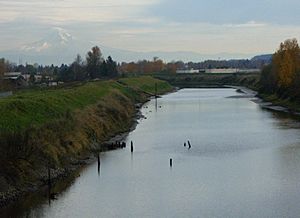East Columbia, Portland, Oregon facts for kids
Quick facts for kids
East Columbia
|
|
|---|---|
|
Neighborhood
|
|

The Columbia Slough in East Columbia
|
|
| Country | United States |
| State | Oregon |
| City | Portland |
| Area | |
| • Total | 2.28 sq mi (5.9 km2) |
| Population
(2020)
|
|
| • Total | 2,205 |
| • Density | 967.1/sq mi (373.4/km2) |
| Housing | |
| • No. of households | 873 |
| • Occupancy rate | 95% occupied |
| • Owner-occupied | 34% |
| • Renting | 55 households (20%) |
| • Avg. household size | 2.5 persons |
East Columbia is a neighborhood in Portland, Oregon. It is located in the northern part of the city, right next to the Columbia River. This area is part of the Columbia River floodplain, which means it's a flat land near a river that can sometimes flood.
East Columbia shares its borders with other neighborhoods. To the southwest, it's next to Sunderland. To the south, you'll find Piedmont and the Columbia Slough, which is a slow-moving waterway. To the west, it borders Kenton. And to the north, it's next to Bridgeton and the big Columbia River.
A lot of East Columbia has wetlands (areas where the land is covered by water) and places for industries. But as you go further east, you'll find more open spaces and homes.
This neighborhood is home to the Columbia Children's Arboretum, a special place for nature and learning. It also has the Columbia Edgewater Golf Club.
Contents
Discovering East Columbia's Past
Early Settlers and Transportation
The first European person to settle in the East Columbia area was John Switzler in 1855. He was important because he started the first post office there. He also ran the first ferry service that took people across the river between Portland and Vancouver.
Schools and Learning in the Community
The very first school in the area, called Columbia School, opened its doors in 1907. For many years, East Columbia had its own school district, the Columbia School District. This district operated from 1920 until 1964. After that, it joined the larger Portland Public Schools system.
From School to Arboretum
When the Columbia School District stopped operating, the original Columbia School building found a new purpose. It was transformed into the Columbia Children's Arboretum. An arboretum is like a botanical garden, but it focuses on trees and shrubs. Many different groups owned this special place over the years. Finally, in 1999, Portland Parks & Recreation took over its care.
Protecting the Land from Floods
Because East Columbia is on a floodplain, protecting it from floods has always been important. Dikes, which are walls built to prevent flooding, have been in place since 1905. These dikes were made even stronger after a very big flood in 1948, known as the Vanport Flood.
Joining the City and Forming a Community Group
East Columbia officially became part of the City of Portland in the early 1970s. To help residents have a voice and work together, the East Columbia Neighborhood Association was created in 1977. This group helps improve the neighborhood for everyone who lives there.
Who Lives in East Columbia?
The United States Census helps us understand the people who live in different areas. According to the 2020 Census, East Columbia is a diverse neighborhood.
- About 46% of the people are non-Hispanic/Latino White.
- Around 25.9% are Hispanic/Latino.
- Other groups make up about 19.7% of the population.
- About 12.5% are Black/African American.
- Around 8.4% are Asian.
- About 4.6% are American Indian/Alaska Native.
- And about 2.2% are Native Hawaiian.
The number of people living in East Columbia has grown quite a bit over the years:
| Historical population | |||
|---|---|---|---|
| Census | Pop. | %± | |
| 1990 | 474 | — | |
| 2000 | 753 | 58.9% | |
| 2010 | 1,772 | 135.3% | |
| 2020 | 2,205 | 24.4% | |

